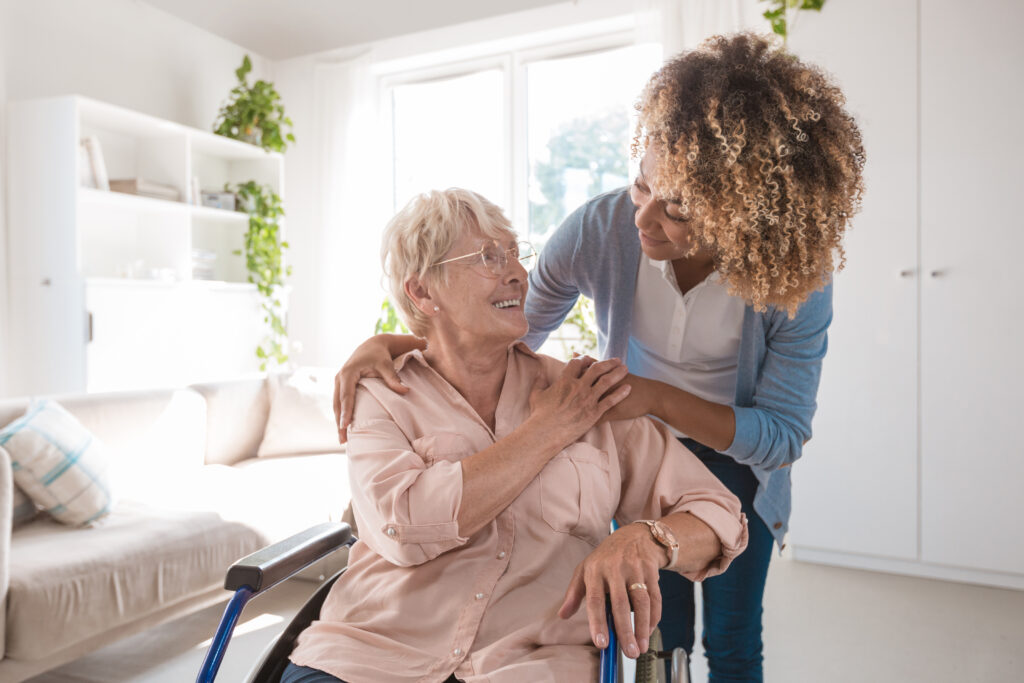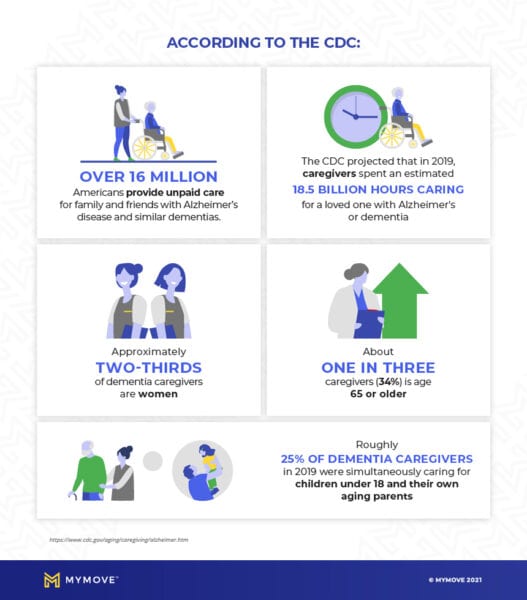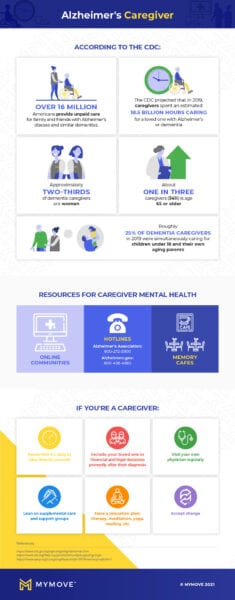Caregiving for Alzheimer’s: Home Modifications for Loved Ones

Alzheimer’s disease is a progressive brain disorder that affects millions of people each year. About 5.5 million people over the age of 65 in the United States have Alzheimer’s, and while it mostly affects older adults, those between the ages of 30 and 65 can also be diagnosed with it. The disease is irreversible and causes a person to lose their memory and eventually forget how to do everyday things like cooking or driving.
Alzheimer’s affects people differently, and some of the ways people are affected by it are grouped by the senses. For example, Alzheimer’s and dementia can affect sight, so adding more visible labels to things in the home can help them. Dementia can also cause people to be unsteady on their feet, so making modifications in a person with Alzheimer’s home can make it safer for them. Renovating the home, or even making small changes, can help an Alzheimer’s patient be more safe and comfortable, and give you peace of mind as a caregiver. Ahead, find our recommendations for a home safety inventory and how to keep your loved one with Alzheimer’s safety top of mind.
In this article:
- Evaluating home safety
- In-home care vs. assisted living
- Resources for in-home caregivers
- Caring for a loved one during COVID-19
- Financial assistance for home modifications
Evaluating home safety
Before you decide on any remodeling or modifications, assess your whole space. Consider all the potential hazards and decide what level of Alzheimer’s safety modification is feasible for your time and budget. Depending on the Alzheimer’s patient’s level of severity, you might focus on certain areas of the home or certain concerns first. For example, if they’re unsteady on their feet or get confused moving around the house, start with things that will help with that, like safety gates for dementia patients. As you go through the home, make a checklist of all the potential issues — where hazardous chemicals are kept, where someone could trip, etc. Once you have a good grasp on where the Alzheimer’s safety issues are, you can start to decide on the changes you’ll prioritize.
Start with basic home renovations

Kitchen
- Remove small rugs from the floor. Only use large rugs with a rubber backing so there’s less of a chance of stumbling or tripping.
- Clearly label hot and cold water on the faucet. This may be painting the knobs different colors or putting a sign on them that’s easy to read.
- Use dishes and placemats in contrasting colors. This will make it easier for an Alzheimer’s patient to see them in the cupboard and to eat off them.
- Get rid of artificial fruits and vegetables. Anything like this can be confusing, so dispose of all of it. This includes even magnets that look realistic.
- Install automatic shut-off on appliances. Any appliances that you can add an automatic shut-off function to, you should. This especially goes for the stove and oven since those are especially hazardous if left unattended. You should also consider stove locks for dementia patients.
- Install child-proof latches. Put these on storage cabinets and drawers in someone with Alzheimer’s home where breakable and dangerous items are held.
Bathroom
- Apply no-slip adhesives in the bath or shower. This will decrease the chance of falling while bathing. This is key when it comes to Alzheimer’s safety products.
- Put a lock on the medicine cabinet. It’s a good idea to prevent access to medications or anything hazardous.
- Install grab bars. Those with Alzheimer’s can lose their balance easily, and grab bars provide more stability.
- Remove the lock from the door. This is two-fold. You don’t want a person with Alzheimer’s to accidentally lock themselves inside the bathroom and you don’t want to be unable to get in and assist in an emergency.
Living room
- Clear out cords. Make sure these are nowhere near where anyone will walk in the home of someone with Alzheimer’s. These are a tripping hazard and need to be kept out of the way for the sake of Alzheimer’s safety.
- Remove small rugs from the floor. Only use large rugs with a rubber backing so there’s less of a chance of stumbling or tripping.
Bedroom
- Install night lights. Make sure there is always some sort of available light, so anyone moving around at night can see.
- Set up a monitor. This is especially important for someone who sleepwalks or gets confused at night. With a monitor that will alert you to motion or out-of-the-ordinary sounds, you’ll be alerted of any emergencies.
- Add seating. Make sure there are ample places for a person to sit — to get dressed, to rest, etc.
- Place mats near the bed. If your Alzheimer’s patient is a fall risk, place mats near and around the bed to cushion them should they fall. Just be sure they don’t obstruct the walkway if they need to get up.
Outdoors
- Block off the pool. Whether it’s with a fence or locks, make sure the pool is inaccessible.
- Keep doorways clear. In general, all areas should remain free and clear of clutter so as to not cause tripping, but be especially careful near doors.
- Lock up hazardous materials. Any pesticides, lawn equipment, or similar items should be firmly locked away.
General home safety
- Post emergency phone numbers. Make sure they’re easy to read and easy to find throughout an Alzheimer’s patient’s home.
- Install smoke alarms and carbon monoxide detectors. Anything you can do to up the safety level is important.
- Mark the doors. Put a bright label or note on doors at eye level, especially if they’re glass, so they’re easy to see.
- Put tape on the stairs. Some with Alzheimer’s experience difficulty with their vision, so by putting bright-colored tape on the edge of the stairs, they will be able to see them better.
More advanced home renovations
- Widen your doorways: Widening doorways in your home for an Alzheimer’s patient can range in price depending on your home, who you hire, and where you live. You can expect to pay anywhere from $300-$3,000 or even more if you’re doing multiple doorways. This can be an important modification to the home, though, if the person living with dementia uses a walker or wheelchair. The wider doorway will make it much easier for them to get around, which, in turn, can lessen frustration associated with mobility. It also makes it easier for a caretaker who is assisting them.
- Wheelchair lift or elevator: If you have someone who is reliant on a wheelchair to get around, you might consider making some larger modifications if possible, like installing a wheelchair lift on the staircases, or even an elevator. These will help keep the person mobile, which can also help them feel a bit of normalcy as their health goes through changes. Lifts and elevators can be pricey in someone with Alzheimer’s home, but you can expect to spend at least $1,500 on this, potentially more.
- Bath remodel: Remodeling a bathroom can include a variety of things to make life easier for someone with dementia. It could include installing a different bathtub, or shower that has a bench or more places to hold on or a door. It could also mean reinstalling a different toilet that’s easier to get on and off of. It could also be changing the lighting, tiles, and sink height. You want to make sure the bathroom is bright enough and that walls and floor are all non-distracting so that the person doesn’t slip while looking at a patterned wall. Also, if the person is in a wheelchair, a lower sink will be easier to access. The prices on all of this will vary based on what you decide to do and who you hire, so the best option is to consider your budget and speak with someone about the remodel to see what’s realistic. With a smaller budget, perhaps the lighting and walls and floor or where you start before moving into bigger changes.
- Ramps: Adding a ramp in and out of the home can make things a lot easier, especially for someone in a wheelchair. The nice thing about ramps is that they can actually be pretty inexpensive to add, depending on where you’re putting it and what you’re looking for. If you’re on a budget, you can purchase a removable ramp for under $300. This way it’s also not a permanent change to the home. To install something more sturdy and permanent, you might spend upwards of $1,000.
In-home care vs. assisted living

It can be difficult to decide between in-home care and assisted living for someone with dementia. While you most likely want to keep the person at home — and they probably want to stay in their own home — sometimes you get to a point where you need more help than in-home care can provide. Here’s what to consider beyond just care equipment for dementia patients.
Your budget will be a large factor, but it will also depend on how much help you need. Around-the-clock in-home caregiver can be very pricey. It will most likely cost more than assisted living. Many assisted living facilities are designed to be budget-friendly for those who need them, and their specific goal is to make life easy and comfortable for their residents.
It also comes down to how much help you need. If someone with dementia needs assistance 24/7, it might be time to consider assisted living. However, if they don’t need full-time help, they might be fine with an in-home caregiver who only spends a few hours a day with them to help them through certain tasks like bathing, taking medications, etc. In-home care will vary in price based on where you live and what you need, but it could cost on average about $30 per hour. This price will most certainly go up for someone offering full-time help.
Assisted living, on the other hand, can cost anywhere from $3,000 per month to nearly $9,000 per month, depending on where you live, though the national average is around $4,000. Special care for those with dementia will also be a surcharge, though that price can vary.
Resources for in-home caregivers

While you’re focused on taking care of a loved one with Alzheimer’s safety, it’s important to keep in mind that your own mental wellness is important too. It’s easy to put someone else’s needs at the forefront of everything you do and shove your own wellbeing aside, but if your own mental health starts to slip, you won’t be as capable of offering help to others. Keep self-care and wellness in mind always, and try some of these tips.
- Find your own support system. You might be the support system for your loved one with dementia, but you can also find a support system of your own. Find Alzheimer’s resources online that will connect you with similar people in your situation.
- Make time for yourself. Being a caregiver can take up a lot of your time, but try to set aside even an hour a day for yourself. Maybe you have in-home care for that hour or another family member step in so that you can have a bit of relief and alone time.
- Meditate. Meditation is often recommended for self-care because it can help you find your zen and recenter yourself. It can help here too, especially if being a caregiver is starting to weigh on you. Spend a few moments each day meditating.
- Go for a walk. A short walk each day can give you that boost of physical movement and a dose of fresh air. This is a good chance to clear your mind and get some exercise.
- Be proactive with legal plans. This may not be an obvious one, but as a caregiver, you’ll have a lot of responsibility as time goes on. Be proactive with helping your loved one navigate legal matters that will come up later on down the line. With both of you taking part in this conversation early, your loved one can better participate and you’ll feel more prepared for when you’re making more decisions later.
- Manage your own health. Make sure you stay up-to-date on your own wellness checks. You need to be in healthy shape to best take care of your loved one.
- Talk to somebody. Therapy is a great resource, especially when going through something like getting an Alzheimer’s diagnosis. Don’t be afraid to find someone to talk to.
- Continue to learn. The more educated you are on Alzheimer’s, the more helpful you are as a caregiver. Speak with your loved one’s doctors and read up on everything you’ll need to know.
Caring for a loved one during COVID-19
The COVID-19 pandemic adds another layer to being a caregiver. Someone with dementia may not only be more susceptible to contracting the virus, but also more prone to spreading it, simply because their memory for proper sanitation isn’t always there. There are ways you can help. The first is to keep an open dialogue with them. Communicate with them about the virus and what everyone needs to do to stay safe. Share the tips for keeping clean and social distancing and remind them of these things as they come up.
You can also make signs to signal to your loved ones with Alzheimer’s that they need to take extra care with some things. Put a sign by the bathroom and kitchen sinks to remind them to wash their hands for long enough and to use soap. Stock up on hand sanitizer and make sure it’s always within reach. If they go out, remind them of social distancing. Consider cutting down on trips out of the house by doing things like getting a larger prescription order or a larger grocery haul.
Financial assistance for home modifications
Making modifications to your home to care for a loved one can be really difficult financially, but fortunately there are programs that can help. A great place to start this search is to look for nonprofits in your area. They might have grants or assistance available. Medicaid is also a route to try, depending on if you qualify. Medicare can likely offer some assistance, especially if your loved one is an older person.
You can also apply for loans for these modifications. There are private loans that you could try, or you could look for a government-funded loan. When it comes to home modifications for these specific purposes, low-interest government loans are available, as well as equipment loans, home improvement grants, and free labor through charity. All of these are designed to help people in need.
Disclaimer: Though we are not experts in this area, we are providing resources that could potentially be of help. The advice we are offering is solely to help individuals look through their options, but when making decisions, you should always reach out to a health care professional for the final say.




